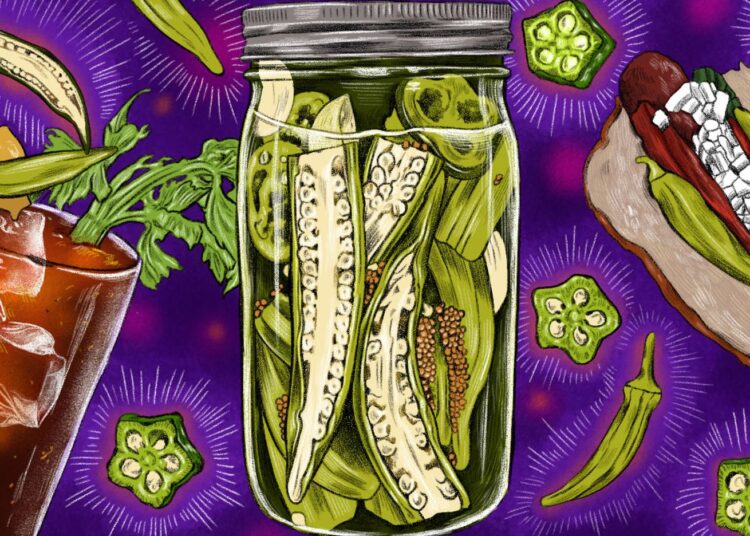Dilek Baykara
Turn these beloved pods into pickles, add them to gumbo, and more
Where I’m from, okra is revered as an emblem of Southern cuisine. Sure, critics of the seed pod may complain about its tendency to get slimy, but that doesn’t stop it from being an essential ingredient in the region’s cooking. With roots in Eastern Africa (and the bulk of production in India), it’s been permanently added to the South’s deep-fried arsenal. You can often find it gracing a barbecue platter in all of its crisp, golden-brown glory, but this firm and velvety fruit is far from a one-trick pony. Yes, it’s essential to good gumbo and pairs well with just about anything on a meat-and-three menu, but okra goes well beyond that.
Think of okra as the most versatile garden crop you can buy. It’s hardy and drought-tolerant, survives the toughest terrain, and is known to produce a surplus. It grows wildly in my parents’ backyard, and I take full advantage in the late summer and fall. I’m a big fan of slicing fresh okra lengthwise and immediately heaping it with smoked trout dip or tzatziki. Raw okra is delightfully crisp with minimal slime and makes a great accompaniment to creamy sauces. Adding delicately cut rounds to a corn salad or charcuterie board provides a slightly sweet, grassy note that’s not overpowering. Choose small okra for easy slicing and a tender bite.
“I love slicing it down, treating it with spices, and giving it an olive oil toss,” says Keshia Hay, a private chef and the owner of BōTANIQUE, a culinary lifestyle brand. “I prefer a crisp play on texture — not necessarily deep-fried, but a nice crunch.” Hay creates sensorial dining experiences in Nashville, Tennessee, and relies on okra to reflect the unique bounty of the area and its narrative. “It’s a part of our story, especially the African-American community, where the seeds came with us to this country,” Hay says. “It’s Southern but is also stretched across global cuisines.”
If you’re going to cook okra, do so with quick, intense heat that decreases the goop found inside the pod. Dry roasting takes top marks for intensifying okra’s flavor, giving a deeply umami quality to its bright, vegetal pop. After roasting, anything is possible: toss the okra into a tofu stir-fry, incorporate it in a veggie omelet, or pile a few pieces on top of cream cheese-slathered toast. Using a searing hot skillet is also a great way to go. Drizzle a small amount of neutral oil, melted butter, or bacon fat to get things started before sauteeing the okra until it turns a toasted brown color. Sauteed okra will feel equally at home in a classic summer succotash or a powerfully spiced bhindi masala — just keep in mind that with more ingredients comes more moisture, and inherently more stickiness.
Chef Brian Mooney, the owner of Tre Luna Bar and Kitchen in Birmingham, Alabama, enjoys okra in all of its iterations. “We use polenta instead of cornmeal before deep-frying — it’s a finer grain and makes for a great crisp,” Mooney says. “I’m also a fan of throwing it on the grill. Salt, pepper, and garlic go a long way when you’re cooking okra over direct heat. You get a little bit of char but maintain that fresh, summery taste.”
It would be an oversight not to mention the popular use of okra in soups like gumbo, Brunswick stew, and Filipino sinigang. Okra’s pods are mucilaginous, meaning they contain a gel-like substance that helps to add body to liquid dishes. While the texture can get a bad rap, folks around the globe love and lean into it, enjoying the mouthfeel and a full-flavored experience.
If you love pucker-inducing tang and science experiments, then try pickling okra. This is my favorite way to enjoy the fruit, and it’s simpler than it seems. Place whole okra pods, garlic cloves, and other aromatics inside a sterile glass jar. Then bring water, vinegar, salt, and additional seasonings to a boil to pour over the pods and seal the container. Let things cool to room temperature before refrigerating. The result is a zesty, briny garnish that can be used to embellish anything you choose — it makes a great hot dog topping, bloody mary trimming, or a casual snack. It’s more proof, in other words, that okra is an all-purpose hero that seamlessly moves from produce section to plate with the simplest preparation. I promise, with the right treatment, you can change your (or someone else’s) mind about this deeply misunderstood ingredient and start experimenting.
Rai Mincey is a food writer and baking enthusiast whose focuses include culinary history, seasonal cooking, and Southern cuisine. She splits her time between Birmingham, Alabama, and Tulum, Mexico.
Dilek Baykara is a Turkish-American illustrator, print designer, and adventurous gastronome living in Brooklyn, New York.














